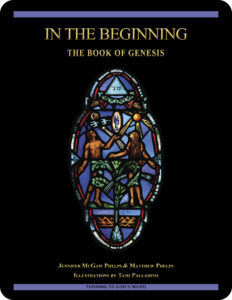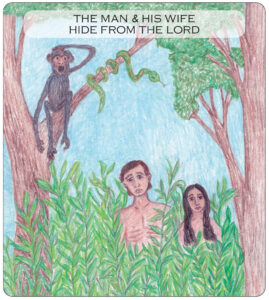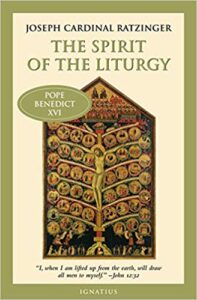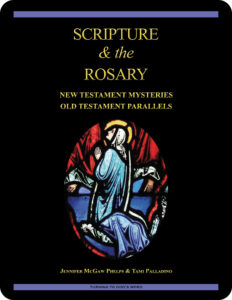 In the Beginning:
In the Beginning:
The Book of Genesis
Lesson 3 The Fall of Adam & Eve
the book of Genesis 3:1–24
Revised Standard Version Catholic Edition (RSVCE)*
New American Bible Revised Edition (NABRE)*
Catechism of the Catholic Church
ex libris (in our library)
cross references in the book of Genesis
next lesson: Cain Rose Up Against His Brother
This material coordinates with Lesson 3 on pages 17–21 in the study book In the Beginning: The Book of Genesis.
“And God saw everything that he had made, and behold, it was very good. And there was evening and there was morning, a sixth day. Thus the heavens and the earth were finished, and all the host of them. And on the seventh day God finished his work which he had done, and he rested on the seventh day from all his work which he had done.”—the book of Genesis 1:31—2:2
welcome to our in-depth study of the book of Genesis
We invite interested groups and individuals to check out the sample first lesson from this 28-lesson  Turning to God’s Word Catholic Bible study.
Turning to God’s Word Catholic Bible study.  These online study pages link to our free lesson video overviews as well as to a list of cross references in the biblical text. Other study aids include maps, charts, illustrations, additional commentary, and prayers based on the primary Scripture in each lesson. In the Beginning: The Book of Genesis has been granted an imprimatur and can be purchased from our website shop. If you have a Bible-study question or comment, click on one of the “ask us your question” or “what do you think” buttons on any online study page.
These online study pages link to our free lesson video overviews as well as to a list of cross references in the biblical text. Other study aids include maps, charts, illustrations, additional commentary, and prayers based on the primary Scripture in each lesson. In the Beginning: The Book of Genesis has been granted an imprimatur and can be purchased from our website shop. If you have a Bible-study question or comment, click on one of the “ask us your question” or “what do you think” buttons on any online study page.
open with prayer
It’s always wise to begin any Bible study with prayer, whether reading the Scriptures alone or meeting with others in a discussion study group. You can pray using your own words or use one of the opening prayers on our website. We especially like the following:
Lord Jesus, you promised to send your Holy Spirit to teach us all things.
As we read and study your word today,
allow it to touch our hearts and change our lives. Amen.
let’s review—the book of Genesis 2:4–25
Lesson 2 It Is Not Good That the Man Should Be Alone describes the second biblical account of Creation. This version of the story differs from the first account in several key ways. Creation begins with God causing a mist to rise from the earth, and from the ground God forms man and breathes into him to give him life. This occurs in the garden of Eden, where the animals are created after God has made man. Woman is created last of all. God treats man almost as his own partner, allowing Adam to name the animals as they’re created. It’s significant that in order to give life to the man, God breathes into him. The breath of God will continue to play an important part in what happens throughout salvation history. It’s also in this second account of Creation that God commands Adam not to eat of the tree of the knowledge of good and evil, a detail that’s missing from the first biblical account of Creation.
hiding from God
Illustrations by Turning to God’s Word co-founder Tami Palladino appear with some lessons in the study book In the Beginning: The Book of  Genesis—including this one. The book of Genesis 3:8 describes the man and woman hiding from God after they’ve eaten from the tree of the knowledge of good and evil, the only thing God commanded them not to do. This story of the fall of our first ancestors demonstrates the predictable reaction of men and women who have sinned—we attempt to avoid coming into contact with God. Later in the same account, both the man and the woman are quick to abdicate personal responsibility for sin, another predictable human reaction. Adam blames his wife, who in turn blames the serpent. The fact is, however, that Eve didn’t force Adam to eat the forbidden fruit any more than the serpent forcefully pushed the fruit down Eve’s throat. Click on the illustration (above right) to enlarge it. Tami’s original illustration is on page 19 in the study book In the Beginning: The Book of Genesis.
Genesis—including this one. The book of Genesis 3:8 describes the man and woman hiding from God after they’ve eaten from the tree of the knowledge of good and evil, the only thing God commanded them not to do. This story of the fall of our first ancestors demonstrates the predictable reaction of men and women who have sinned—we attempt to avoid coming into contact with God. Later in the same account, both the man and the woman are quick to abdicate personal responsibility for sin, another predictable human reaction. Adam blames his wife, who in turn blames the serpent. The fact is, however, that Eve didn’t force Adam to eat the forbidden fruit any more than the serpent forcefully pushed the fruit down Eve’s throat. Click on the illustration (above right) to enlarge it. Tami’s original illustration is on page 19 in the study book In the Beginning: The Book of Genesis.
 a new character enters the picture (01:48:25)
a new character enters the picture (01:48:25)
In the ancient world, being subtle or cunning wasn’t considered a positive  attribute. That the serpent’s described as being more subtle than any other creature suggests a problem is about to present itself to the first man and woman that God has created. Turning to God’s Word author Matthew Phelps looks at how it is that the serpent goes about leading Adam and Eve to disobey the only commandment given to them by God. It’s worth considering why the serpent was
attribute. That the serpent’s described as being more subtle than any other creature suggests a problem is about to present itself to the first man and woman that God has created. Turning to God’s Word author Matthew Phelps looks at how it is that the serpent goes about leading Adam and Eve to disobey the only commandment given to them by God. It’s worth considering why the serpent was  successful then, and what Christians can learn from this cautionary biblical tale that’s relevant in the present day. What might have led to the serpent’s success in leading Adam and Eve astray?
successful then, and what Christians can learn from this cautionary biblical tale that’s relevant in the present day. What might have led to the serpent’s success in leading Adam and Eve astray?
The Scripture ranges for the videos that accompany this Catholic Bible study from Turning to God’s Word match the Scripture ranges for the sets of questions in the study book In the Beginning: The Book of Genesis. You can follow along as author Matthew Phelps discusses Lesson 3, “The Fall of Adam & Eve,” on pages 17–21 in the study book.
links to things in the video
Turning to God’s Word co-founder Tami Palladino suggests that people thinking about the ideas in this video might find these links helpful:
- Ancient Holy Saturday Homily (on the Vatican website)
- Easter Proclamation (on the USCCB website)
WHAT DO YOU THINK about being separated from God because of sin?
Let’s examine one of the more serious questions raised by the biblical text in this lesson: Who acts to cut the man and the woman off from the presence of God?
 ? What role does the serpent play? What is it that the serpent actually does?
? What role does the serpent play? What is it that the serpent actually does?
? Consider whether the serpent’s actions alone are enough to cause a break in the relationship between God and humanity. What else is necessary before such a rift can occur?
? What action of the woman causes her to be cut off from God’s presence?
? Do you think that it’s fair for the woman to blame the serpent?
? Consider whether the woman’s action alone is enough to cause a break in her husband’s relationship with God.
? What does the man do that causes him to be cut off from God?
? Is it fair for the man to blame his wife?
? Consider why both the man and the woman seek to avoid responsibility for their actions.
? When have you attempted to shift the blame for your own moral failings to someone else?
? Why did you wish to avoid responsibility for sin?
? What aid does the Church offer for those who are able to admit to their own moral failings?
seraphim—you could look it up in our archives
 We think of serpents as creatures that slither on the ground, but the book of Genesis 3:14 indicates this wasn’t always so. That the serpent must travel on its belly is a punishment from God. To learn the connection between the words “serpents” and “seraphim,” read Lost in Translation, an online column in which Turning to God’s Word author Matthew Phelps helps readers connect with ideas expressed in the original languages of the Scriptures. New Lost in Translation entries are posted on Mondays, and past entries are archived on our website. Contact us if you’d like to receive Lost in Translation by email every week.
We think of serpents as creatures that slither on the ground, but the book of Genesis 3:14 indicates this wasn’t always so. That the serpent must travel on its belly is a punishment from God. To learn the connection between the words “serpents” and “seraphim,” read Lost in Translation, an online column in which Turning to God’s Word author Matthew Phelps helps readers connect with ideas expressed in the original languages of the Scriptures. New Lost in Translation entries are posted on Mondays, and past entries are archived on our website. Contact us if you’d like to receive Lost in Translation by email every week.
the popes inspire us—the mysterious presence of the kingdom of God in history
In a papal audience on December 13, 2000, Pope St. John Paul II addressed the consequences that the Fall of Adam and Eve has for men and women in the present day:
 “Unfortunately, man often carries out the mission assigned to him by God not as a wise artisan but as an overbearing tyrant. In the end, he finds himself in a devastated and hostile world, in a shattered and divided society, as the book of Genesis further teaches us in the great fresco of the third chapter, which describes the breaking of the harmony between man and his fellow human beings, the earth. and the Creator himself. This is the result of original sin, that is, of the rebellion that occurred at the very beginning of the plan entrusted to humanity by God.
“Unfortunately, man often carries out the mission assigned to him by God not as a wise artisan but as an overbearing tyrant. In the end, he finds himself in a devastated and hostile world, in a shattered and divided society, as the book of Genesis further teaches us in the great fresco of the third chapter, which describes the breaking of the harmony between man and his fellow human beings, the earth. and the Creator himself. This is the result of original sin, that is, of the rebellion that occurred at the very beginning of the plan entrusted to humanity by God.
“Therefore, with the grace of Christ the Redeemer we must once again make our own the plan of peace and development, of justice and solidarity, of the transformation and wise use of earthly and temporal realities foreshadowed in the first pages of the Bible. We must continue humanity’s great adventure in the fields of science and technology, discovering nature’s secrets.
“As the Psalmist sings in Psalm 104, in the morning ‘man goes forth to his work and to his labor until the evening.’ In his parables Christ also refers to this work of man and woman to illustrate symbolically the mystery of the kingdom of God and of its gradual realization. Although the Christian knows that this work often is frustrated by evil and sin, by selfishness and injustice. The mysterious presence of the kingdom of God in history sustains and enlivens the Christian’s commitment to his earthly tasks.”
 Prayed at Sunday Vigils (Week II), Psalm 104 will be included as part of Lesson 15 Let Us Ring Out Our Joy to the LORD in the Turning to God’s Word Catholic Bible study Sing a New Psalm: Communicating with God Through the Prayers of the Church—Volume II: Vigils, Day Prayer & Compline, scheduled for release in summer of 2024.
Prayed at Sunday Vigils (Week II), Psalm 104 will be included as part of Lesson 15 Let Us Ring Out Our Joy to the LORD in the Turning to God’s Word Catholic Bible study Sing a New Psalm: Communicating with God Through the Prayers of the Church—Volume II: Vigils, Day Prayer & Compline, scheduled for release in summer of 2024.
ex libris—another papal view of theology of the body

 Looking for more information about theology of the body? Check out The Spirit of the Liturgy by Pope Benedict XVI. This work, aimed at helping readers deepen their understanding of the “great prayer of the Church,” looks at the essence of worship, the Jewish roots of Christian prayer, and the relationship of the liturgy to time and space. The section on liturgical form contains comments about the purpose of priestly vestments. At ex libris—main bookshelf, learn more about this and other works related to Bible study.
Looking for more information about theology of the body? Check out The Spirit of the Liturgy by Pope Benedict XVI. This work, aimed at helping readers deepen their understanding of the “great prayer of the Church,” looks at the essence of worship, the Jewish roots of Christian prayer, and the relationship of the liturgy to time and space. The section on liturgical form contains comments about the purpose of priestly vestments. At ex libris—main bookshelf, learn more about this and other works related to Bible study.
“…Thus the theology of clothing becomes a theology of the body. The body is more than an external dressing up of man—it is part of his very being, of his essential constitution. And yet  this body is subject to decay. It is only a tent. It is provisional. But, at the same time, it is an anticipation of the definitive body, the definitive and complete form of human existence. The liturgical vestment carries this message in itself. It is a ‘further clothing,’ not an ‘unclothing,’ and the liturgy guides us on the way to this ‘further clothing,’ on the way to the body’s salvation in the risen body of Jesus Christ, which is the new ‘house not made hands, eternal in the heavens’ (the Second Letter to the Corinithians 5:1). The Body of Christ, which we receive in the Eucharist, to which we are united in the Eucharist, saves us from ‘nakedness,’ from the bareness in which we cannot stand before God. In the context of this teaching of Saint Paul, I am very fond of the old formula for the distribution of Holy Communion: ‘The Body of our Lord Jesus Christ preserve thy soul unto everlasting life.’ These words turn the teaching of the Second Letter to the Corinthians 5:1–10 into prayer.”
this body is subject to decay. It is only a tent. It is provisional. But, at the same time, it is an anticipation of the definitive body, the definitive and complete form of human existence. The liturgical vestment carries this message in itself. It is a ‘further clothing,’ not an ‘unclothing,’ and the liturgy guides us on the way to this ‘further clothing,’ on the way to the body’s salvation in the risen body of Jesus Christ, which is the new ‘house not made hands, eternal in the heavens’ (the Second Letter to the Corinithians 5:1). The Body of Christ, which we receive in the Eucharist, to which we are united in the Eucharist, saves us from ‘nakedness,’ from the bareness in which we cannot stand before God. In the context of this teaching of Saint Paul, I am very fond of the old formula for the distribution of Holy Communion: ‘The Body of our Lord Jesus Christ preserve thy soul unto everlasting life.’ These words turn the teaching of the Second Letter to the Corinthians 5:1–10 into prayer.”
 the best Catholic commentary about Scripture
the best Catholic commentary about Scripture
To find out more about how Church teaching is supported by Scripture passages in In the Beginning: The Book of Genesis, check out the Index of Citations in the Catechism of the Catholic Church. Links (Revised Standard Version Catholic Edition [RSVCE*]) to the primary Scripture passages in the lesson and relevant paragraphs in the Catechism are provided here. Not every passage in the biblical text for this Catholic study is referenced in a Catechism paragraph, however.
the book of Genesis 3:1–5—paragraph 391
the book of Genesis 3:1–11—paragraph 397
the book of Genesis 3:1–24—paragraphs 390, 2795
the book of Genesis 3:3—paragraph 1008
the book of Genesis 3:5—paragraphs 392, 398, 399, 1850
the book of Genesis 3:6—paragraphs 2541, 2847
the book of Genesis 3:7—paragraph 400
the book of Genesis 3:8–10—paragraph 29
the book of Genesis 3:9—paragraph 410, 2568
the book of Genesis 3:9–10—paragraph 399
the book of Genesis 3:11—paragraph 2515
the book of Genesis 3:11–13—paragraph 400
the book of Genesis 3:12—paragraph 1607
the book of Genesis 3:13—paragraphs 1735, 2568
the book of Genesis 3:14–19—paragraph 2427
the book of Genesis 3:15—paragraphs 70, 410, 489
the book of Genesis 3:16—paragraphs 376, 400, 1607, 1609
the book of Genesis 3:16–19—paragraph 1607
the book of Genesis 3:17—paragraph 400
the book of Genesis 3:17–19—paragraph 378
the book of Genesis 3:19—paragraphs 376, 400, 1008, 1609
the book of Genesis 3:20—paragraph 489
the book of Genesis 3:21—paragraph 1608
the book of Genesis 3:24—paragraph 332
to learn more, read more Scripture
If you’re having difficulty with a particular passage of Scripture, it can be helpful to read the relevant  cross references—but looking these up can take time. To make that easier, we’ve compiled the cross references from the Revised Standard Version Second Catholic Edition (RSV2CE)—the translation that we reprint in our study books. That list can be found at the top of every online study page, and it includes links to cross references in the primary biblical text for In the Beginning: The Book of Genesis.
cross references—but looking these up can take time. To make that easier, we’ve compiled the cross references from the Revised Standard Version Second Catholic Edition (RSV2CE)—the translation that we reprint in our study books. That list can be found at the top of every online study page, and it includes links to cross references in the primary biblical text for In the Beginning: The Book of Genesis.
don’t forget about our indexes & extra online material

 If you’re trying to locate information about a specific Scripture passage, you can look it up in the index at the back of the study book or sample lesson. If you want to find a particular commentary, you can look up its title in the topics index. To learn more about another book of the Bible for which there’s a Turning to God’s Word study, visit the online study directories to read the commentaries and watch any accompanying videos. Finally, if you have a question or would like to make a comment about any of our studies, you can use one of the “ask us your question” or “what do you think” buttons to email our authors.
If you’re trying to locate information about a specific Scripture passage, you can look it up in the index at the back of the study book or sample lesson. If you want to find a particular commentary, you can look up its title in the topics index. To learn more about another book of the Bible for which there’s a Turning to God’s Word study, visit the online study directories to read the commentaries and watch any accompanying videos. Finally, if you have a question or would like to make a comment about any of our studies, you can use one of the “ask us your question” or “what do you think” buttons to email our authors.
ex libris—Church documents & books about religious topics
Link to magisterial documents referred to in our Bible studies at ex libris—magisterial documents.  This listing includes significant recent encyclicals as well as a number of historical Church documents. Recommended books related to Scripture study can be found at ex libris—main bookshelf.
This listing includes significant recent encyclicals as well as a number of historical Church documents. Recommended books related to Scripture study can be found at ex libris—main bookshelf.
wondering how to pronounce some of these words?
The following link is to a reading from the New International Version (NIV) Bible. To listen, open the link and click on the audio icon above the printed text. Although not taken from the translations used in our study materials, the NIV reading provides an audio guide to pronunciation of words in this lesson’s primary biblical text. A close online version of the translation of the Bible used in Catholic liturgy in the United States as well as an audio guide for daily Mass readings for the current month can be found on the website of the United States Conference of Catholic Bishops (USCCB).
the book of Genesis 3:1–24 (NIV)
 close with Bible-based prayer related to this lesson
close with Bible-based prayer related to this lesson
Many of our Catholic study groups like to conclude their discussions with a prayer based on the scriptural focus of their lesson, and some participants include Scripture-specific prayer in their individual study. If you’re uncomfortable composing your own Bible-based prayers, you can follow our four easy steps. If you prefer, you can use the following prayer based on this lesson’s text from the book of Genesis.
O God, when our earliest ancestors Adam and Eve disobeyed you,
you set in place the means to save humanity.
Teach us to appreciate the love that you’ve shown to us
in the face of our human weaknesses.
Help us to turn to your Son, Jesus Christ,
whenever we’re tempted to prefer self-interest over your love.
We ask this in Jesus’ name. Amen.
Lesson 4 Cain Rose Up Against His Brother—the book of Genesis 4:1–26
Lesson 2 It Is Not Good That the Man Should Be Alone—the book of Genesis 2:4–25
you also may like our study of Scripture & the Rosary (digital only)
 Scripture & the Rosary: New Testament Mysteries, Old Testament Parallels, a 26-lesson Catholic Bible study with an imprimatur, looks at the biblical foundations of the Rosary. The study includes lessons on Pope St. John Paul II’s Rosarium Virginis Mariae (Rosary of the Virgin Mary), the Apostles’ Creed, and the Luminous Mysteries as well as the original 15 Mysteries of the Rosary. Color photographs of stained glass windows depict key scenes in the lives of Jesus and Mary. Free digital lessons rotate throughout the year on our website.
Scripture & the Rosary: New Testament Mysteries, Old Testament Parallels, a 26-lesson Catholic Bible study with an imprimatur, looks at the biblical foundations of the Rosary. The study includes lessons on Pope St. John Paul II’s Rosarium Virginis Mariae (Rosary of the Virgin Mary), the Apostles’ Creed, and the Luminous Mysteries as well as the original 15 Mysteries of the Rosary. Color photographs of stained glass windows depict key scenes in the lives of Jesus and Mary. Free digital lessons rotate throughout the year on our website.
start a Turning to God’s Word Bible study
 Thank you for your interest in our study In the Beginning: The Book of Genesis.
Thank you for your interest in our study In the Beginning: The Book of Genesis.  Information about beginning a Turning to God’s Word Catholic Bible study can be found at start a Bible study. Tami, Matthew, and I are available to answer questions and offer support. Contact us if you’d like to start a Turning to God’s Word study or have your schedule listed with other TtGW study groups on our website. —Jennifer
Information about beginning a Turning to God’s Word Catholic Bible study can be found at start a Bible study. Tami, Matthew, and I are available to answer questions and offer support. Contact us if you’d like to start a Turning to God’s Word study or have your schedule listed with other TtGW study groups on our website. —Jennifer
*There are seven deuterocanonical books in the Old Testament—the Books of Tobit, Judith, Wisdom, Sirach, Baruch, and First and Second Maccabees, as well as some passages in the Books of Esther and Daniel. Protestants usually refer to these works as “apocryphal,” a word that means “outside the (Protestant) canon” because they’re excluded from most Protestant Bibles. The word “deuterocanonical” means “second canon”; Catholics use that word to refer to any section of the Catholic Old Testament for which there are no extant, or existing, Hebrew manuscripts. All of the deuterocanonical books appear in the Septuagint, the earliest remaining versions of which date to the 1st century B.C. This Greek translation of the Old Testament was in common use by Jews at the time of Jesus—but the same books aren’t found in existing Hebrew manuscripts, which aren’t as old as the oldest version of the Septuagint. Learn more by reading How Do Catholic & Protestant Bibles Differ?
Turning to God’s Word printed Bible studies use the 2006 Revised Standard Version Second Catholic Edition (RSV2CE) translation for all Scripture references except those to the Psalms, which are taken from The Abbey Psalms and Canticles, prepared by the Benedictine monks of Conception Abbey and published in 2020 by the United States Conference of Catholic Bishops (USCCB). All Scripture links for the online study pages for In the Beginning: The Book of Genesis are to the 1966 Revised Standard Version Catholic Edition (RSVCE) translation. The New International Version (NIV) audio recordings follow the same chapter and verse numbering as the RSV Catholic translations, but the NIV translation doesn’t include the deuterocanonical books and passages.
The 1966 RSVCE uses archaic pronouns and verb forms such as “thee,” “thou,” “didst” in the Psalms and in direct quotations attributed to God. The 2006 RSV2CE replaces those with more accessible English. The few significant translation changes in the RSV2CE include rendering almah as “virgin” in the Book of Isaiah 7:14 and restoring the term “begotten” in the Gospel According to John 3:16.
Numbering varies for some passages in this Bible study. Turning to God’s Word studies (print and digital) follow the numbering in the Revised Standard Version Catholic translations (RSV2CE and RSVCE). Discrepancies in the New American Bible Revised Edition (NABRE) are noted in the Index of Scripture Citations in the study book and the online sample.
 You can learn more about the Psalms by viewing a sample lesson from the Turning to God’s Word Catholic Bible study Sing a New Psalm: Communicating with God Through the Prayers of the Church—Volume I: Lauds & Vespers. The second part of that study, Sing a New Psalm: Communicating with God Through the Prayers of the Church—Volume II: Vigils, Day Prayer & Compline, is scheduled for publication in 2025. Some verse numbers may vary in different translations of the Psalms.
You can learn more about the Psalms by viewing a sample lesson from the Turning to God’s Word Catholic Bible study Sing a New Psalm: Communicating with God Through the Prayers of the Church—Volume I: Lauds & Vespers. The second part of that study, Sing a New Psalm: Communicating with God Through the Prayers of the Church—Volume II: Vigils, Day Prayer & Compline, is scheduled for publication in 2025. Some verse numbers may vary in different translations of the Psalms.
